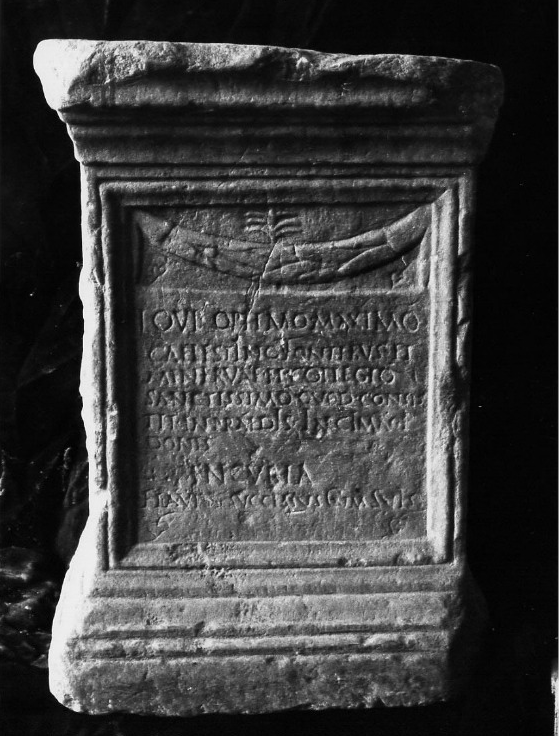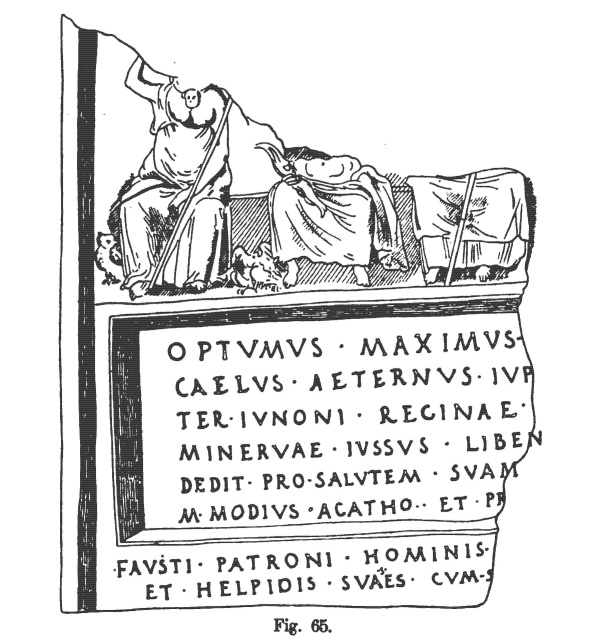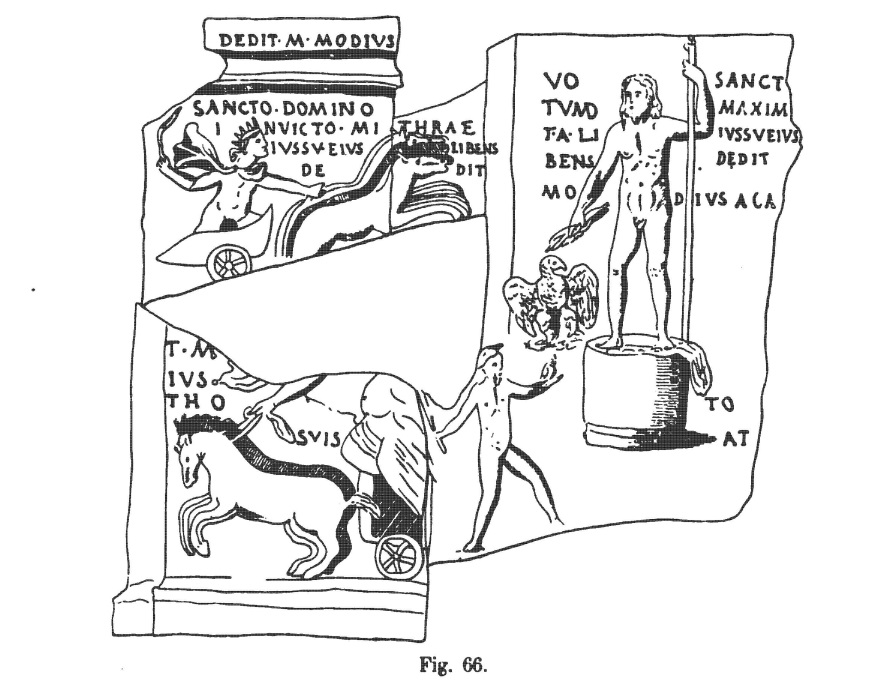
CIMRM 327, 328, 329, 330, 331, 332, 333 - Monuments of Marcus Modius Agatho found in 1555 on the Caelian hill. Rome, Italy.

Vermaseren includes as CIMRM 330 a statue base, also mentioned by Cumont as then in the "palais ducal d'Urbin". On the right is Minerva, on the left a bearded man, lying down on a rock. The inscriptions appear front and back. The first inscription suggests that it once supported a statue of Jupiter. The reference to fontes, springs, is used by Cumont1 to link this item to the Mithraic cult of springs. Larcius Macedo was consul suffect in 122 AD. A description of the item is online.2
CIMRM entry
ROMA (Reg. II)
327.
On the Caelius a Mithraeum seems to have existed on the spot where nowadays the Piazza della Navicella is situated, or in its immediate surroundings (cf. Colini, Storia Celio, 48). Here in May 1555 the two following monuments were discovered, dug up by Girolamo Altieri "in area Divae Mariae semper Virginis in Coelio monte cognomento in Domnica" (cf. B. Aegius in a note to the Bibliotheca of Apollodorus, f. 1,2.1; .see CIL VI 81). These monuments were transported to the Palazzo Altieri al Gesù, and were copied here by Pighius (Bibl. Berl. ms. lat. A 61 f. 9) and by Giovantonio Dosio (cf. Huelsen in Ausonia VII, 1912, 24 who prints these copies after folios from the Bibliotheca Marucelliana at Florence, ms. 100 fol. 150a and 148).
Of the Mithraeum itself nothing has been preserved; through excavations "nella Cava alla Navicella" in 1771 blocks of travertine came to light (Colini, 236).
328.
A relief, now lost.
Jahn, Codex Pighianus, 184 No. 82; Aegius, Ms. Vat., 5241 f. 118; MMM II 233f No. 71bis, a with fig. 65; Vermaseren in Vigiliae Christianae IV, 1950, 143; Mithrasdienst in Rome, 58f.
The relief is in white marble and divided into two parts. Above a tabula in which an inscription No. 329, three gods are seated in a row. In the centre Jupiter. with naked torso; in his r.h. he holds a thunderbolt and next to his r, foot an eagle is perched. On his left sits Juno, entirely dressed; she holds a long staff. On the other side Minerva, with the aegis on her breast. In her l.h. a lance and her r.h. touches the helmet. By her side an owl. The upper part of the relief is broken off, so that Minerva has been preserved as far as her neck, Jupiter up to his breast and Juno as far as her hips.
329.
CIL VI 81; MMM No. 59.
Optumus maximus / Caelus aeternus Iup[i]/ter Iunoni Reginae / Minervae iussus liben[s] / dedit pro salutem suam / M(arcus) Modius Agatho et pr[o] / Fausti patroni hominis s(ancti?) / et Helpidis suae s(anctae?) cum s[uis].
330.
This monument may be compared to a small marble base, seen by Smetius in Rome in the 16th century "in domo Iordani Ruchabellae ad S. Laurentium in Damaso ad Campum Florae" (MMM II 414 No. 293). The base, on which a representation of Minerva and a lying water-god, probably supported a statue of Jupiter. The inscription on the front is worth mentioning:
331.
CIL VI 404; MMM II No. 554.
Iovi optimo maximo / caelestino fontibus et / Minervae et collegio / sanctissimo quod consis/tit in praedis Larci / Macedonis. / In curia. / Flavius Successus cum suis.
This inscription may refer to a Mithras-community.
332.
Three fragments of a white marble relief. Lost.
MMM II 234f No. 71bis, b and fig. 66.
1) Standing, naked Jupiter, holding his sceptre in his l.h. and his thunderbolt in his r.h. He stands on a base, on which his chlamys lies. Beside him an eagle with his wings spread out, looking up to him. Before the base stands a naked youth in Phrygian cap, lifting a torch with his outstretched r.h.; in his outstretched l.h. a bird (cock?) is perched. In the field an inscr. No. 333, 1.
2) Sol, dressed only in a flying shoulder-cape, stands in a quadriga, urging on the horses with a whip. On his head a radiate crown. The hindmost part of the horses and part of the wheel have got lost. Above it the inscr. No. 333,2.
3) Luna, of whom only a few traces are left, stands in a chariot drawn by two horses. In the field remnants of the inscr. No. 333, 3.333.
CIL VI 82; MMM II No. 60.
1) [Domi]no sanct[o / o]ptimo maxim[o / sa]lutari iussu eius / libens dedit / [M(arcus)] Modius Ag/[atho] cum / [suis pro Faus]to / pat[rono].
2) Dedit M. Modius [Agatho] / sancto domino / invicto Mithrae / iussu eius libens / dedit.
3) [Lunae... / M.] M[od]/ius [Aga]/tho [cum] / suis permissu .....
Bibliography
- M.J. Vermaseren, Mithriaca IV: le monument d'Ottoviano Zeno. p.49: "...ce thème de l’Éternité de la Triade Capitoline, exprimé pour la première fois sur le fronton du Capitole(113), est répété deux fois sur les monuments mithriaques trouvés près de l'église de Santa Maria in Domnica sur le Célius. On se souviendra (voyez supra p. 6) qu’à la même époque où fut découvert le bas-relief Magarozzi (= Zeno) la famille des Altieri faisait aussi des fouilles peut-être au même endroit. Les monuments trouvés à cette occasion furent répartis entre deux villae : M. Meli Altieri conservait dans son palais prés de l’Église de S. Gesù le bas-relief représentant Mithra debout sur le taureau (Pl. IX) et un relief de Mithra tauroctone (Pl. X), tandis que Jérôme (Hieronymus Altieri) conservait les fragments de quatre autres bas-reliefs dans sa villa près de St. Jean de Latrans (Pls IV-VII). Ces derniers bas-reliefs sont perdus depuis le XVIIe siècle mais ils nous sont connus par des dessins de Giovanntonio Dosio (114) et de Pighius(115). L’un des reliefs représente la Triade Capitoline, le second le quadrige du Soleil et le troisieme le bige de la Lune: une combinaison, done, qui maintenant n’etonne plus personne. Un quatrieme bas-relief, enfin, represente Jupiter seul, debout sur une base circulaire: devant lui s’approche un dadophore (Cautes?) qui semble tenir sur sa main gauche un oiseau (coq?). Ces quatre bas-reliefs portent tous des inscriptions dediees par M. Modius Agatho, qui doit avoir ete un affranchi d’un certain Faustus. Les inscriptions(116) sont parfois fragmentaires, et si elles nous ont ete bien transmises par les dessins, l’usage du latin montre clairement que le dedicant etait oriental, puisqu'il reserve pour ses dieux la denomination de son pays d’origine. Le bas-relief du Soleil est dedie a Mithra, sanctus dominus invictus; Jupiter est appele dominus sanctus maximus salutaris et sur le relief de la Triade il est optumus maximus Caelus aeternus Jupiter. Nous voyons done que Mithra et Jupiter peuvent porter des epithetes identiques et que le Jupiter romain comme un Ba’al syrien cst identifie avec le Ciel eternel. M. Modius Agatho est caelo devotus et astris (117) et a dedie ses bas-reliefs en raison de sa profonde admiration pour la revolution etemelle des astres presidee par le Soleil qu’est Mithra."
| 1 | TMMM II, p.174, inscr. 554-5, note. |
| 2 | here: Date, 2nd c. AD. "Piccola ara marmorea. Zoccolo e coronamento, composti da varie cornici, corrono tutt'intorno al monumento. Il dado centrale ha sulla fronte, entro srrono tutt'intorno al monumento. Il dado centrale ha sulla fronte, entro specchiatura ribassata e delimitata da cornice, iscrizione preceduta da fespecchiatura ribassata e delimitata da cornice, iscrizione preceduta da festone con palemtta al centro.tone con palemtta al centro. Nella sesta linea sembra esserci una parte abrasa. Un Larcius Macedo fu legato in Galatia nel 122 d.C.La faccia posteriore è attualmente manomessa dgato in Galatia nel 122 d.C.La faccia posteriore è attualmente manomessa da una profonda cavità. Sui fianchi sono scolpiti, rispettivamente, un fiuma una profonda cavità. Sui fianchi sono scolpiti, rispettivamente, un fiume sdraiato a sinistra e Minerva presso un'ara a destra.e sdraiato a sinistra e Minerva presso un'ara a destra." A second inscription reads: "T(itus) Flavius Successus d(ono) d(edit)". Museo Lapidario, Palazzo Ducale, p.zza Duca Federico, 107, Urbino, Urbino (PU) - Pianterreno. Al centro della sala II a, fuori specchio, inv. 41115 (1986). Accession no 41115 (1986). Height cm 45.5; width: cm 32; other: cm 27.5. There seems to be a photograph, "documento fotografico: SA AN 61710", with filename "11-00015158/Bassa/SA AN 61710.jpg", although I have been unable to find it. |
| Tweet |

